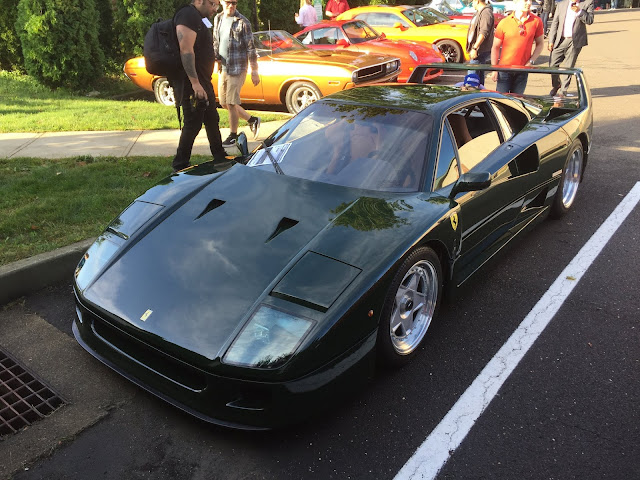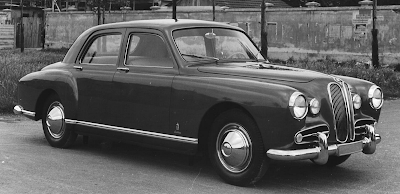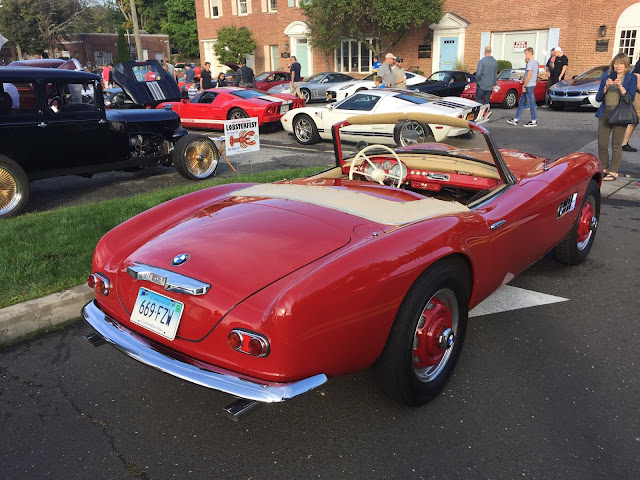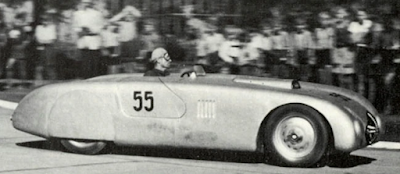The late summer car festival at the Lime Rock* track in Connecticut encompassed vintage racing, a concours and car club gatherings. If you missed those events, it appears you could have attained an automotive nirvana almost as complete by visiting the Cars and Coffee event in New Canaan…
This Riley Nine below from the 1930s looks to be a Brooklands or Speed model. These had an 1,100 cc inline four with twin low-mounted cams operating overhead valves through short pushrods. The idea, similar to the Lea-Francis four and postwar Talbot Lago inline six, was to offer hemispherical combustion chambers without the complexity of overhead cams.
The spartan but well-instrumented cockpit and boat tail give the little club racer a purposeful aspect. The first Brooklands model appeared in 1929.
The Cisitalia* competition coupe from the late 1940s is powered by a modified Fiat inline four of 1,100 cc. Piero Dusio's firm found brief success after WWII with small but expensive alloy-bodied racers and road cars, the most famous of which were the finned road racers named for Tazio Nuvolari, the driver who put them on the podium, and the predictive Pinin Farina GT coupes which appeared with them in 1947.
The body design of this Cisitalia is less sophisticated than those models, and appears to reflect a single-minded focus on road racing. The high, tapered boat tail resembles some Zagato-bodied Fiat Panoramicas from the same period, but this car lacks the curved side window sections and compound-curved rear windows of those cars...
The '57 Alfa Romeo Giulietta Sprint shown below was one of Bertone's first high-volume production cars, and also the first Giulietta to appear when the series was introduced in 1954.
Franco Scaglione's design* shows toned-down versions of the themes in his show cars, including the parabolic arc of the roof section and rear window, the emphasis on aerodynamics over surface decoration, and the emphasis on weight-saving. The sliding side windows are an example of the latter, and were featured on the lightweight Sprints, while most GT coupes had winding windows.
Albrecht Goertz's design for the BMW 507* roadster dates from 1956 through '59. Hatched from a desire by BMW to re-enter the two-seater market they'd last visited with the prewar 328, and New York dealer Max Hoffman's wish to have something slotted between the Porsche Speedster and the Mercedes 300SL in price, the 507 succeeded in looking like the perfect car for the jet set before there even was a jet set. In the price department it failed to meet Hoffman's program, as it was almost $2,000 more than the 300SL Gullwing. Just over 250 of the graceful V8 roadsters were built.
Where the graceful 507 failed commercially, the equally graceful Jaguar E-Type* introduced half a decade later succeeded wildly. Much of this was about William Lyons' production team, including designer Malcolm Sayer, hitting the right price point. The E-Type was about $4,000 less than the 507 at its US introduction in April 1961...
This is a Series One 4.2 liter car, introduced late in 1964 and built through 1967.
The Ferrari 330 GT 2+2 from the same era was once considered a bit too tame and civilized owing to its 4 seats and also the 4 headlights that appeared on early models...
All this has been forgiven by enthusiasts today, and collectors are chasing these V12 touring cars with the enthusiasm they once reserved for lightweight road racers.
The BMW CSL"Batmobile" of the mid-70s re-established BMW's road racing profile in the European Touring Car race series. In keeping with the theory and practice of race car design in the 1970s, the aerodynamic add-ons seem to take up more space than the bodywork. They definitely take up more of the spectator's attention...
The Batmobile interior makes for a striking contrast with the Ferrari 330GT, and shows just how elastic a term like "Touring Car" had become by the time this car was raced in a touring car series...
The Ferrari F40 below, introduced by Enzo's team to celebrate the 40th anniversary of Ferrari's founding in 1987, is unusual not only because it's a seldom-seen supercar, but because it's dark green...
No Cars & Coffee would be complete without a mystery car, and this one had a couple. The first is what appears to be a 1931 Cadillac roadster. But Cadillac made V8s, V12s and V16s in that year, and we're not sure whether this is a V8 or V12...
And here's another mystery, a 21st century supercar with De Tomaso insignia. This is the P72 prototype introduced last summer. It's supposed to recall Pete Brock's design for De Tomaso's P70* racer from the mid-Sixties. One of 72 examples planned, and powered by a supercharged Roush Mustang V8 with a claimed 700 hp. At $800,000 a copy, interested parties will need more technical details, and maybe financial assistance...
*Footnote: The Lime Rock Concours is surveyed in our post for Sept. 17, 2019, while the Cisitalia saga is detailed in "Fiats as Fine Art", from April 15, 2017. The story of the BMW 507 is recounted in "That Other Five Series," from Oct. 20, 2019. Franco Scaglione's designs for Bertone and Alfa Romeo are analyzed in "The Arc of Success", our post for Dec. 20, 2017. And the racing career of the Jaguar E-Type is reviewed in "Racing Improves the Breed", from Aug. 13, 2017. Finally, Pete Brock's design for the original De Tomaso P70 is pictured in "Unsung Genius: Pete Brock, Car Designer", our post from Jan. 16, 2017.
Photo Credit: All photos were taken and submitted by LT Jonathan D. Asbury, USN.
Photo Credit: All photos were taken and submitted by LT Jonathan D. Asbury, USN.























































